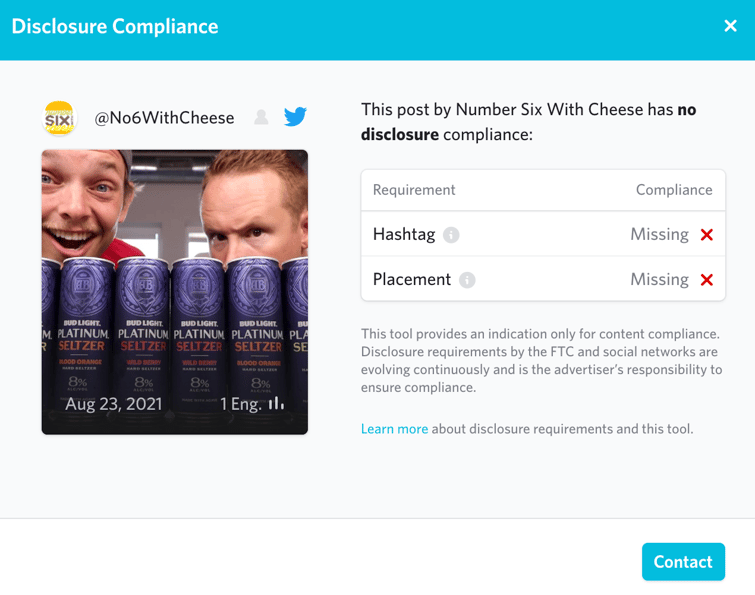In the recent months, the FTC has taken great strides to level the playing field with a group that previously were not impacted by standard regulations in traditional marketing.
Back in April 2017, The Federal Trade Commission (FTC) sent letters to approximately 90 celebrities, athletes, influencers and brands reminding them of the need to disclose any “material connection” between the influencer and the brand. The letter goes on to clarify that a material connection could consist of a business or family relationship, monetary payment, or the provision of free products. Important note here, free product needs to be disclosed!
The majority of the responsibility falls on the brand to enforce guidelines with the influencer. Just put yourself in the frame of mind of the FTC. If a large brand seeks out 30 micro- and power influencers with a fan base from 5,000 to 100,000 followers and they were not properly directed on the requirements to disclose, the FTC will go after the largest player, which in most cases is the brand.
Here are five tips to implement in your future campaigns to keep your brand protected and help your influencer partners tell better stories about the relationship.
1. Have a clear policy on HOW and WHAT to disclose
Be transparent from the onset. Set some internal guidelines on how you will require your influencer partners to disclose the relationship. Familiarize yourself with each platforms disclosure requirements. This is especially important if your campaign spans multiple platforms. Instagram for example, has different requirements from Twitter.
2. Enforce it by tracking content and step in when changes need to be made
Social Media Marketing Managers have a lot to manage. From finding the influencer, negotiating rates, sending out the gifted product, to managing the content and making the payments. Now they need to make sure the influencer is actually doing what they agreed to with regards to legal compliance. Since this is not a statistic most marketing executives ask about at the weekly meetings, it often gets overlooked. Find a way to track compliance and build it into your process.

3. Refuse to work with influencers who break the rules.
One of the most difficult parts of running an influencer marketing campaign is balancing the campaign direction with the influencer and their own artful expression. It is a delicate dance that brands need to master. One thing that cannot suffer is the need for legal compliance. This should be a non-negotiable. Before you go too far down the creative path, check back on the influencers prior posts. Have they clearly disclosed in the past? If not, have a straight forward discussion about it before moving forward. Remember, the majority of the legal and financial responsibility will fall on the brand.
4. Make the partnership part of the story
Let’s not forget that the reason influencer marketing is so powerful is the credibility between the influencer and their audience. Built in trust is what sets this type of marketing apart from a print or television ads. Authenticity is key to success.
When I first heard that Gary Vaynerchuk was coming out with a sneaker from K-Swiss, my initial thought was less than positive. It seemed like a way to capitalize on his personal brand and not much more. Until I saw a 20 minute video with Gary and Barney Waters, President of K-Swiss. They talked in detail about the project and why they felt it was a good thing for entrepreneurship in general. They pulled the curtain back on everything from the design process to total inventory that would be produced for the initial run. They made the partnership a part of the story.
If the trust is real their fans won’t mind them sharing an honest opinion of a product they really like which brings us to the next tip.
5. Seek out long-term partnerships, not one-off campaigns
One of the most seamless ways to ensure proper compliance adoption is to seek out long-term relationships with influencers. Once you run a few successful campaigns and it is clear that they understand how to weave it into their story telling, stick with them. You will see greater returns have less stress chasing down FTC compliance. By the same token if different campaigns require working with different influencers, highlight those that have done it well as part of your own internal best practice play book.
I am sure we have not seen the last of these guideline changes. As influencer marketing moves from the Wild West to a more traditional and necessary form of marketing to survive, things will continue to evolve. Be sure to stay ahead of the curve. The sooner you establish a culture where compliance is demanded, the easier it will be to adjust.
Ryan Sprance is the Founder of Kaihatsu Media, a Digital Marketing agency focused on developing brand awareness through social media growth, optimizing digital marketing spend and influencer marketing programs. He is also the Creator & Editor-In-Chief of TheStylishMan.com and contributing editor for Julius.
-1.png?width=239&name=Julius%20By%20Triller%20-%20Wordmark%20-%20Purple%20(1)-1.png)







